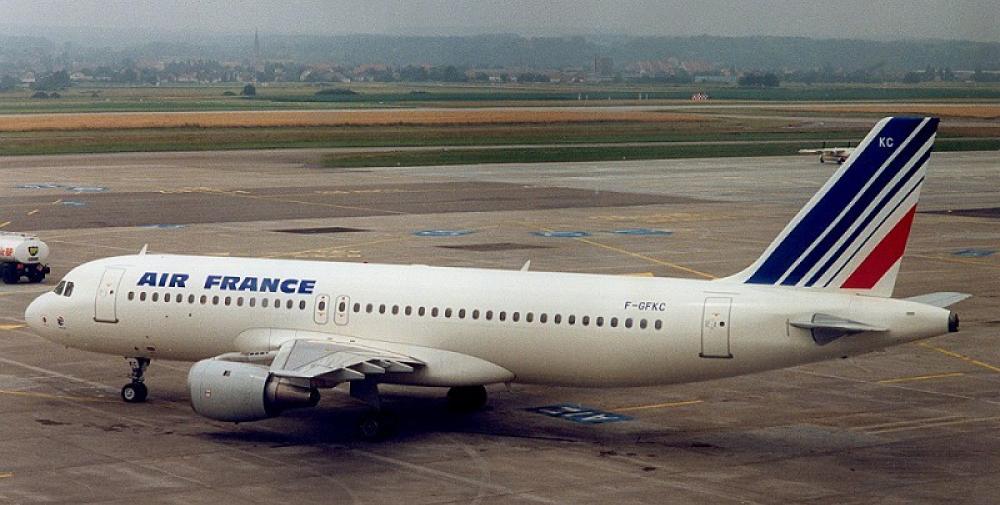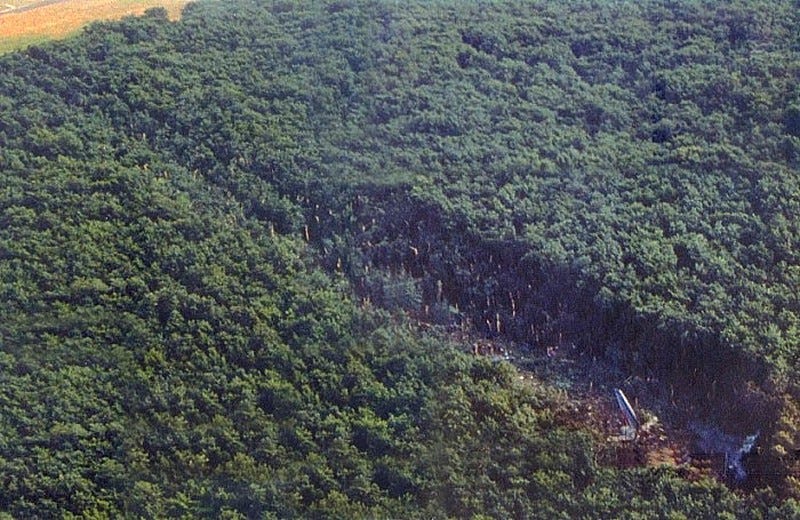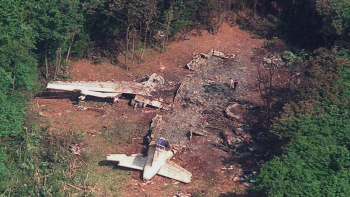On June 26, 1988, Air France Flight 296Q took off for a sightseeing tour, participating in an airshow in the process. As the flight performed a low-altitude pass over a runway, it could not climb fast enough and eventually crashed into a forest at the end of the runway. Official reports concluded the cause of the accident to be pilot error. However, the flight captain, Captain Michel Asseline, had a different story to tell the world.
Flight Details
Air France Flight 296Q was a special chartered flight from Charles de Gaulle Airport (CDG), headed for Basel-Mulhouse Airport (EAP), with a flyover expected at Mulhouse-Habsheim Airfield. As this was a promotional flight for the then brand-new Airbus A320, tickets were awarded as a prize for a raffle contest. The Mulhouse Flying Club at Mulhouse-Habsheim requested that the A320 do a flyover as there were airshows during that time. After the flyover, the A320 will take a sightseeing flight over the Alps and land at Basel-Mulhouse. The program included a returning flight for the passengers after they landed at Basel.
The flyover was planned to be over a paved runway, runway 02. After passing over the runway, the A320 will climb steeply with full power, using TO/GA (Takeoff/Go Around) mode and come back, flying over the same runway in the opposite direction. The flyover altitude was 100 feet (30 meters), with the gear down and flaps lowered at a very low speed (however, this was lower than the minimum altitude designated by French law).
The first officer would manually control the throttle to maintain speed and altitude. Normally, this would cause the A320 to engage a safety feature called "Alpha Floor", where the computer would signal the aircraft to enter TO/GA mode when the nose angle is above 15 degrees when flying higher than 100 feet. This is to prevent the aircraft from entering an aerodynamic stall. To prevent this, the captain will disengage the alpha floor on this flight.
There is another flight protection feature called "Alpha Protection", where if the A320 reaches a nose-up angle of 14.5 degrees, it will limit the angle to 17.5 degrees to leave a margin about a stall. This feature is prioritized over other modes and activates as soon as the angle of attack reaches 14.5 degrees, and the crew cannot disengage from it.
This flight was not an ordinary Air France flight but was operated by Air Charter International on behalf of Air France. Air Charter International took care of the flight plans and aircraft choice, as Air France only had three A320s in its fleet. Hence, the aircraft operated with a callsign "AIR CHARTER 296 QUEBEC". Air France was also the launch customer for the Airbus A320.
The aircraft involved was an Airbus A320-111 with registration F-GFKC. It first flew on January 6, 1988, and was delivered new to Air France on June 23, the same year. The aircraft was only six months old when it crashed three days later.

This aircraft was one of three A320s that Air France operated then. It was named Ville d'Amsterdam, after the capital of the Netherlands. Two CFM56 engines powered the aircraft.
The flight crew consisted of two pilots, Captain Michel Asseline and First Officer Pierre Mazières. Captain Asseline, age 44, was a highly distinguished pilot, having more than 10000 flight hours, and has previously flown the Caravelle, Boeing 707, 727, 737, and Airbus A300 and A310. Asseline was also the head of training for the A320 flight and was heavily involved with testing the Airbus A320. Asseline had 138 flight hours on the A320 before the incident.
The first officer, Pierre Mazières, age 45, was a highly distinguished pilot with more than 10000 flight hours. He flew the Caravelle, Boeing 707 and 737. He was qualified as captain of the A320 three months before the incident. Mazières had 44 flight hours on the A320 before the incident.
There were 130 passengers and six crew members on board. Two female passengers were seated inside the cockpit. As mentioned above, most passengers were raffle ticket winners who had never flown on an airplane before. This became a problem later, as the passengers were confused with how to operate airplane seatbelts, which mechanically differ from car seatbelts.
The Accident
The pilots received the flight plan the morning of the flight. After briefing the flight plan, Flight 296Q departed Charles de Gaulle and headed for Mulhouse. As Mulhouse-Habsheim airfield was too small to be listed on the aircraft's computer database, the crew had to approach the airfield visually. However, as the A320 approached the airport, the crew noticed the crowd gathered on runway 34, a short grass runway, rather than runway 02, the paved runway in the flight plan. The captain had to change course at the last minute, and this caused the approach path to become destabilized. As a result, the altitude decreased to 40 feet as the aircraft approached the runway.
As mentioned above, runway 34 was a short grass runway at Mulhouse. At the end of runway 34 was a forest; from above, the forest looked like a different color of a grass runway. As the A320 flew over runway 34 at 40 feet, the flight crew noticed that the runway was much shorter than expected, and this was the moment they realized that they were approaching the forest at the end of the runway.
Seeing this, Asseline ordered Mazières to apply TO/GA thrust, and Asseline pulled back on his control stick to climb. However, the aircraft did not respond as Asseline expected. Alpha Protection did not allow it to point its nose further up (as the plane was below 100 feet, Alpha Floor was already automatically disabled). The brand new A320 flew into the treetops, with the engines congesting leaves and branches. The trees increased drag and slowed the aircraft down, and the engines failed as the combustion chambers inside the engines became clogged. The plane crashed into the forest with an explosion, as the right wing was torn off, spilling fuel.
Evacuation
Initially, all passengers survived the crash. However, as mentioned above, many passengers were struggling with their seatbelts as they were unfamiliar with them. This delayed the evacuation process.
As the aircraft crashed, all electric power was lost without emergency lighting except for the exit signs. The purser tried to use the public addressing system, but it failed as the cords were cut off. The front galley had sparks flying around with smoke as short circuits were happening there. As soon as the aircraft came to rest, passengers reported smoke and flames coming out of the floor through rows 10 to 15. The flight attendants started opening the doors and directing passengers to their nearest exit.
The left front door failed to open as tree branches blocked it from opening. As it opened partially, the evacuation slide inflated inside the aircraft. The purser and a passenger were pushed out onto the ground as the door opened fully, with the slide landing on them. Passengers started evacuating the aircraft in a rush and piling at the end of the slide as branches inhibited escape. The purser and a flight attendant started clearing the slides from branches to facilitate the evacuation.

A flight attendant that was positioned at the center of the aircraft was carried away to the front, as she was pushed into the aisle by a badly burnt passenger sitting in 12F. She then tended to a passenger whose clothes were on fire at the same time as she was carried away to the front left door. She then replaced the flight attendant at that door and resumed her duties. At this time, fire was entering the right side of the aircraft through the windows at rows 8 to 9.
After the evacuation of the last passenger through the left front door, she called into the cabin to confirm that nobody was still there. After that, the captain, having evacuated the injured First Officer, ordered this flight attendant to evacuate, and she left the aircraft. The captain then returned to the cockpit to retrieve an anti-smoke mask and go through the cabin to search for any other survivors. He had to leave before he used it, as he started suffering from the fumes. The flight attendants could not use the masks as they were preoccupied with opening the doors properly.
A passenger later said he failed to open the left overwing exit. This was a blessing as the left wing was covered with raging fires then. The rear portion of the aircraft was evacuated quickly as there were no difficulties opening the doors. Also, there was no smoke in the rear of the cabin, contributing to the fast evacuation. One passenger helped passengers, especially the elderly, who had difficulty moving. Branches punctured the slide during the evacuation, so flight attendants had to help passengers deplane the aircraft.
After the last passenger evacuated through this door, the fumes and smoke started reaching the rear. The flight attendant had to retreat from the cabin and only shouted in the direction of the cabin. As smoke blocked the crew members' vision, they could not know the situation on their opposite sides. Therefore, crew members went around the wings towards the front or rear doors to see if they could help.
All 6 crew members survived the crash. Asseline and Mazières received minor head injuries and also suffered from smoke inhalation and shock. The flight attendants suffered from bruises but did not have any bone injuries. Of the 130 passengers, three died due to smoke inhalation. A tetraplegic young boy in 4F seemed to have remained in his seat.
A young girl seated in 8C could not unbuckle her seatbelt and was blocked by the seatback of 7C (her front seat), which tilted over onto her. A woman who was sitting in 10B (who was travelling with her husband) initially reached the front door but seemed to have returned to the cabin to help the girl in 8C, as her body was found near the girl.
The fire was eventually put out. There were difficulties in accessing the crash site as the roads were tight in the forest. Fortunately, hospitalization of the injured went smoothly, as there were few people hurt, and most of them had minor injuries. The crash site was also near Mulhouse, and the hospital was able to execute a smooth emergency plan.
Around 20 passengers went home or to a hospital by hitching a ride on the nearby road without visiting the emergency center. This complicated tasks for the rescuers, as these people were considered missing. Two hectares of forest, mainly young oak and birch trees, were destroyed.

Investigation
The Bureau of Enquiry and Analysis for Civil Aviation Safety (BEA), a counterpart to the NTSB in America, started investigating the crash. The investigative team analyzed flight data recorders (they were not destroyed as they were in the aircraft's tail section, the only part that did not burn). It simulated the same approach using another A320 at the long runway at Toulouse Airport. They found that the aircraft responded properly to the flight crew's inputs, and the engines operated normally.
The official report from BEA concluded that the following causes added up to the crash of Flight 296Q:
- Very low flyover height that was lower than surrounding objects (in this case, the forest)
- Very low speed and reducing to reach maximum possible angle of attack
- Engine speed at flight idle
- Late application of go-around power
Other factors were also noted, such as insufficient flight preparation (as the pilots were given the flight plan on the day of the accident), overconfidence of the captain regarding the new safety features, late identification of the airfield, no experience of demonstration flights, and the holiday atmosphere of spectators and passengers transmitted to the captain.
Other Explanations
However, Asseline did not believe that pilot error was the cause of this crash and asserted that there was a problem with the A320's fly-by-wire controlling system. Asseline says that the aircraft did not respond to the throttle inputs when he advanced the throttle to TO/GA mode. As the A320 neared the forest, he was worried that the throttle malfunctioned and responded by pulling it back to idle and pushing it back to full throttle, by which the aircraft had already started to touch the leaves. Asseline also says the flight data recorders were missing four seconds compared to the control tower tape's playtime. He insists that he applied thrust earlier than shown in the data.
Mayday, an air crash investigation documentary, also mentioned the possibility of the computer at fault. The aircraft was below 100 feet, so it might have been programmed to enter landing mode. This might have prevented the pilots from making unexpected maneuvers, as the aircraft was nearing the ground, and thus restricted the pilots from climbing, instead landing into the forest ahead.
The Institute of Police Forensic Evidence and Criminology, based in Switzerland, claims that the flight data recorders might not even be the ones found in the wreckage of Flight 296Q. Asseline also mentioned in Mayday that the flight date recorders looked very old, while the A320 was only 6 months old at the time of the crash. Airbus denied this in 1991, saying that the BEA report confirmed that the aircraft followed the flight crew's controls normally, especially the throttle controls. As the throttle was at flight idle as it approached the forest, the engine took longer to spool up and provide full thrust. The BEA report shows that the A320's engines were operating normally until it started sucking in leaves and branches.
Aftermath
Eight years later, in 1996, Asseline, Mazières, two Air France officials and the president of the flying club at Mulhouse Airfield were all charged with involuntary manslaughter and were all found guilty the next year. Asseline was sentenced to 6 months in prison and 12 months probation, while Mazières was given a 12-month suspended sentence.
The others were sentenced to probation. Asseline appealed to France's highest court, the Court of Cassation (Cour de Cassation in French). However, he was required to submit himself to prison before the Court of Cassation could take his case. The next year, in 1998, Asseline's appeal was rejected, and his sentence was increased to 10 months of imprisonment, with 10 months of probation.
After the crash of Flight 296Q, France banned passengers from boarding all demonstrating flights that included maneuvers not included in the operating manual. The BEA suggested that flights participating in airshows have sufficient time for preparation and effective survey of where the flight is to be placed. It is also recommended that the internal rules of airlines be checked for compliance with official regulations, as the 100-foot altitude in the flight plan was lower than the required minimum altitude of 170 feet in visual flight range conditions.
Thousands of Flights Impacted as Winter Storm Blair Hits U.S. » Export Development Canada Secures Aircraft Repossession in Nigeria Under Cape Town Convention » Bomb Threat Cancels Air New Zealand Flight, Delays Passengers »
Comments (0)
Add Your Comment
SHARE
TAGS
STORIES Air France Airbus A320 First Flight Airshow Crash Charles de Gaulle Basel Mulhouse Habsheim Paris IncidentRECENTLY PUBLISHED
 Could You Survive a Plane Crash? The Unlikely Science of Plane Crash Survival
With air travel consistently being heralded as the safest form of public transport, most of us do not board a plane pondering our chances of survival in the event of a crash. But, is it possible to survive one?
INFORMATIONAL
READ MORE »
Could You Survive a Plane Crash? The Unlikely Science of Plane Crash Survival
With air travel consistently being heralded as the safest form of public transport, most of us do not board a plane pondering our chances of survival in the event of a crash. But, is it possible to survive one?
INFORMATIONAL
READ MORE »
 Maldivian Airlines Introduces First-Ever Widebody Aircraft, Plans New China Flights
Maldivian, the government-owned national airline of the Maldives, has just welcomed its first-ever wide body aircraft: the Airbus A330-200. With the new aircraft, the carrier also plans brand-new long haul international flights to China.
NEWS
READ MORE »
Maldivian Airlines Introduces First-Ever Widebody Aircraft, Plans New China Flights
Maldivian, the government-owned national airline of the Maldives, has just welcomed its first-ever wide body aircraft: the Airbus A330-200. With the new aircraft, the carrier also plans brand-new long haul international flights to China.
NEWS
READ MORE »
 Thousands of Flights Impacted as Winter Storm Blair Hits U.S.
Winter Storm Blair has unleashed a huge blast of snow, ice, and freezing temperatures across the Central and Eastern United States.
As of Sunday afternoon, over 6,700 flights and counting have been disrupted. This includes cancelations and significant delays leaving passengers scrambling to change flights and adjust travel plans.
NEWS
READ MORE »
Thousands of Flights Impacted as Winter Storm Blair Hits U.S.
Winter Storm Blair has unleashed a huge blast of snow, ice, and freezing temperatures across the Central and Eastern United States.
As of Sunday afternoon, over 6,700 flights and counting have been disrupted. This includes cancelations and significant delays leaving passengers scrambling to change flights and adjust travel plans.
NEWS
READ MORE »





